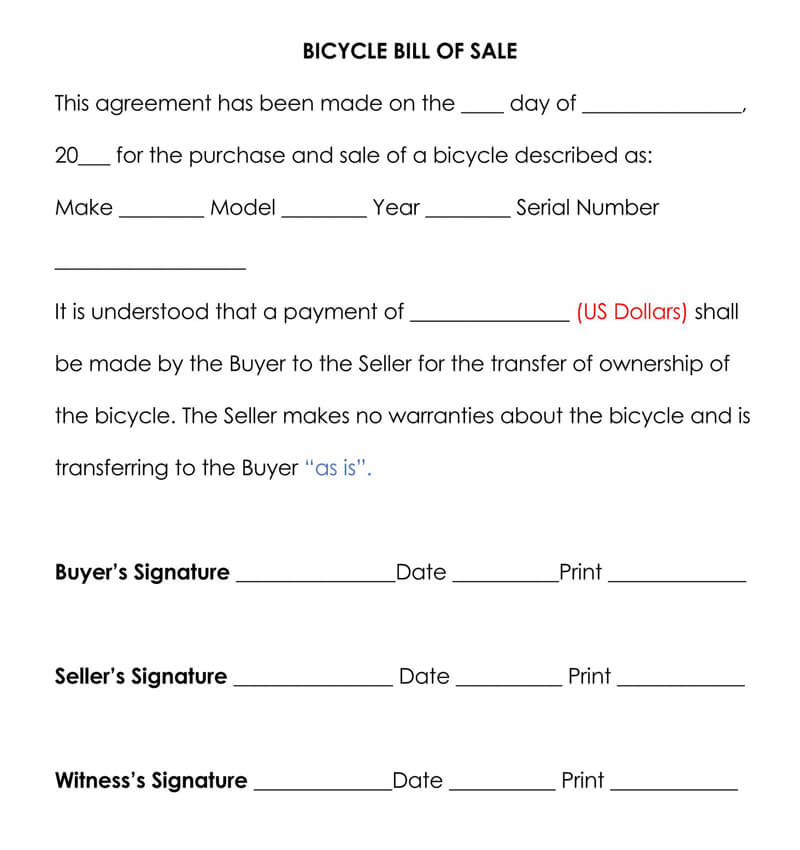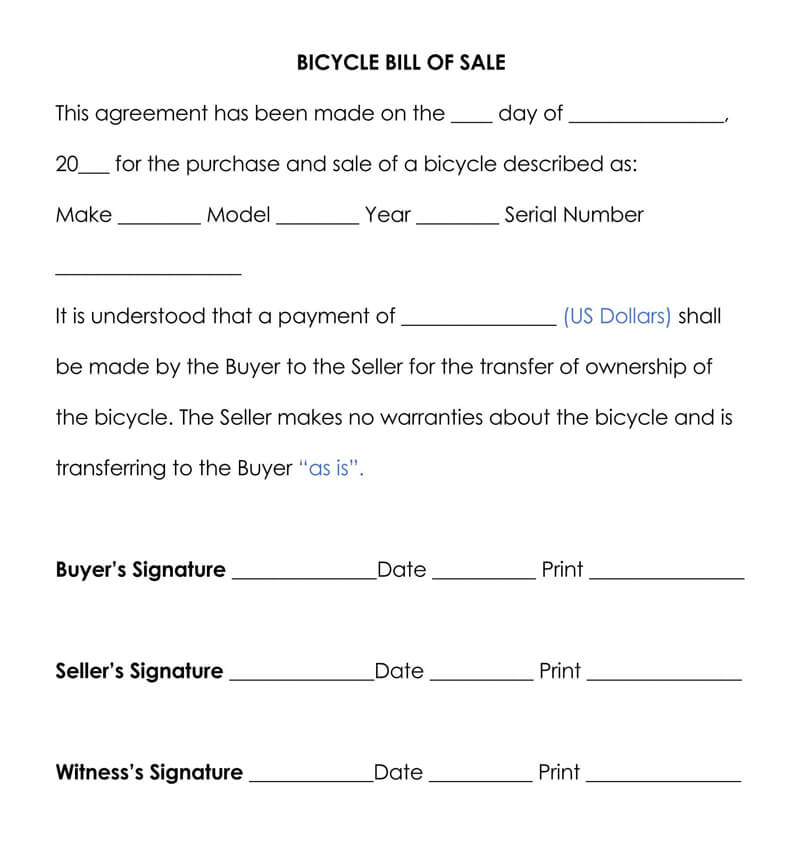A Bicycle Bill of Sale Form is a simple document that proves the legal purchase and sale of a bicycle between buyer and seller and proves a change of ownership.
Riding a bike is a fantastic pastime, and it’s easy to feel attached to your bicycle. But when it’s time to sell your bike, it’s best to be as businesslike as possible. So here we will help you with the details of selling your bike effectively. That starts with a bicycle bill of sale form that acts as proof of purchase.
In addition, the bicycle bill of sale form provides information regarding the identification of the bike, the cost of sale, and signatures acknowledging the sale between the parties.
Why Do I Need a Bicycle Bill of Sale Form?
A bicycle bill of sale form can be used as a receipt, providing proof of ownership. It also can provide several details about the bicycle, which is very helpful to the buyer. Providing information on the bicycle bill of sale form, such as the year the bike was built, the brand, and the specific model is excellent information for the new owner.
Let’s say the new owner wants to buy new parts, tires, or accessories for the bike. Knowing the basics will help them in their search.
If the bike is stolen, the bicycle bill of sale form is a valuable aid when making a police report or filing an insurance claim. The bill of sale form is proof of the identifying details, which would help locate and identify the bike. It is also proof of the bike’s potential replacement cost.
A bicycle bill of sale form is a helpful tool for a quick and easy “as-is” sale.
The Meaning of “As-Is”
When you advertise your bicycle for sale “as-is,” the buyer knows that the bike will be sold in its current condition. Therefore, they can’t request repairs or improvements to the bike as a condition of sale.
If you plan to sell your bike as-is, let prospective buyers know as much about the bike as possible. If you’ve replaced components of the bike recently, make a note of this in your listing. Let buyers know how recently you’ve replaced the tires or had the bike tuned up. Approximate mileage is helpful. If you have extra inner-tubes or the original pedals, be sure to include those details. A used bike may not be good as new, but you still want to point out its attributes and fine points.
Elements of a Bicycle Bill of Sale Form
You can download a sample bicycle bill of sale form from our website.
The bicycle bill of sale form includes the following information:
- Date of sale
- Buyer’s name and address
- Seller’s name and address
- Specific bike information – Year, make, model, serial #, and color
- Sale amount
- Buyer’s name printed, signature and date
- Seller’s name printed, signature and date
- Witness’ name printed, signature, and date (if any)
A copy of the completed bicycle bill of sale form is given to the buyer, and the seller can make a copy. Once the money and the bike change hands, the sale of the bike is complete.
How to Sell Your Bike
Follow the given steps to sell your bike:
Repairs
First, you need to make any repairs the bike needs. Look for signs of wear or broken components. If these are easy fixes, taking care of them will help you to get a better price.
When a potential buyer sees your bike for the first time, they will probably want to take it for a spin. Therefore, the bike must operate in peak condition so that the buyer can appreciate it.
If you are not experienced with bike repairs or don’t have the proper tools, you may need to bring your bike to your friendly local bike shop.
If your bike is heavily damaged, you will need to set the price low, as the buyer will need to take the time, effort, and money to get the bike into good shape. On the other hand, if the bike is high-end, getting the work done before it is offered for sale may be worth it. However, it could increase your asking price by a significant amount.
If the bicycle is antique, you should leave it untouched – unless you have a professional bike restoration shop. Professional collectors of bicycles often prefer that bikes be in their original condition, and decisions about restoration are best left to those who have significant experience with antique valuations.
Cleaning
A thorough cleaning of your bike is essential. A clean bike looks much better in photos than a grimy one and will also operate better.
For cleaning, you’ll need a bucket of hot, soapy water, some clean and dirty sponges, a degreaser, and bike oil. Apply the degreaser to the chain, chainring, and cassette first, and let it sit. Use a sponge and hot water to clean the bike from front to back and top to bottom. Remove the wheels and wash the tires, sidewalls, and spokes thoroughly.
Wash the forks and brake calipers. Use an old, dirty sponge, clean the chain, cassette, and use a flat-head screwdriver to scrape off any gunk. Clean all the nooks and crannies with a small brush. Examine your tires, bike rims, and brakes for any debris and clean off. Pop the wheels back on and rinse the whole bike carefully. Re-lube the chain and chainring and wipe off the excess.
Besides helping the bike be clean, sparkling, and look its best, this process will help the bike perform better and help it be more attractive to prospective buyers.
Evaluate the sale price
You will want to do some research to evaluate the asking price for your bicycle. This can be very straightforward with the use of the internet.
The Bicycle Blue Book (Value Guide) is the cycling industry’s definitive valuation authority and is a beneficial online tool. Just enter the year, brand, and model of your bicycle, as well as the condition. The Blue Book will report the average price for which the bike could sell.
Another online resource, Checkaflip, provides data on items recently sold on eBay. In addition, you can find the average selling price of specific items, including bikes like yours.
Be prepared to negotiate the price. Have your ideal price in mind, but also determine the lowest amount you’re willing to accept. Keep an open mind and be reasonable with your price. This will help ensure you find a buyer within a decent amount of time.
Choose an appropriate place to sell your bike
There are a lot of options for how and where to sell your bicycle. It’s safest and easiest to sell your bicycle to someone you know!
Facebook or other social media can be beneficial. If you’re a member of cycling groups or bicycle sale pages on Facebook, those are a great place to start. Facebook Marketplace, Craigslist, and eBay are all excellent options.
You will need to take photos of your bike for online listings. Find an uncluttered spot to display the bike and make sure that you have good lighting. Natural light can work well. Take a variety of photos that show the bike from several angles, both close-up and at a distance. Be sure to take clear photos of any flaws.
A reputable used bike store is an option to consider, and pawn shops are also possibilities. These brick-and-mortar options are convenient but be prepared for them to offer a low price. They will need to resell your bike at a higher cost. Brick-and-mortar stores should be considered if your online listings haven’t helped you find an interested buyer within 30-60 days.
If you sell your bike to someone you don’t know, make sure to meet the prospective buyer in a public place where there are other people around. Make adequate time to look at the bike, check any issues, and negotiate a price.
Make sure any prospective buyers have a chance to check the bicycle over for any issues and see if they’d like to take a test ride. Make sure to ask for collateral, such as their driver’s license, to ensure they return from the ride.
Conduct negotiations
Once the buyer makes an offer, you can counter back with a better price. Negotiate your price but be respectful. If you’ve waited long to find a buyer, you may need to take a lower price.
Once you and the buyer agree on the price, secure payment, Facebook Marketplace now allows online payments so that the buyer can make the payment on the spot with their phone. But, of course, cash is always a safe option as well.
Complete the bicycle bill of sale form
Here is how to fill the bicycle bill of sale form:
- Obtain the form online (see our website) and print
- Write the sale price
- Add the seller’s information
- Add the buyer’s information
- Include the bicycle’s specific details
- Write the date and affix signatures of all parties
Complete the transaction
Once the funds have been secured, the buyer and seller can sign the bicycle bill of sale form. The buyer keeps the completed form, but the seller can make a copy for their records if they like. Ensure to provide the buyer with any documentation or manuals, accessories, stands, tools, or other parts that initially came with the bike.
Free Templates
Following are some free downloadable bicycle bill of sale form templates for you:
Final Words
While all the details may seem overwhelming, once your bike finds its new owner, everything will make sense, and you will be glad you did the work. In addition, an official bicycle bill of sale form will help the new owner feel more secure in their purchase and help you know that you’ve done things right!


